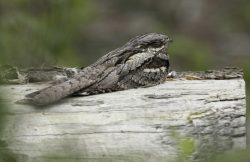 NIGHTJARS, one of our most mysterious and elusive birds, are making a comeback, according to the latest report from the RSPB – numbers across the bird charity’s reserves in England and Wales hit a record high in 2022, up 11 per cent on 2021.
NIGHTJARS, one of our most mysterious and elusive birds, are making a comeback, according to the latest report from the RSPB – numbers across the bird charity’s reserves in England and Wales hit a record high in 2022, up 11 per cent on 2021.
RSPB Arne in Dorset, where the number of territorial male nightjars has tripled from 20 in 1990, will feature as the live filming location for this year’s series of Springwatch, on BBC television from 29th May to 15th June.
Survey results from 2022 included a record 60 territorial males at RSPB Arne – the increase is due to the efforts of a team of conservationists, aided by four-legged helpers including cattle, pigs, ponies and donkeys,
Nightjars migrate to the UK each year from their wintering grounds in Central Africa. Typically found on lowland heathland in the UK, their numbers fell in part because of habitat loss and the resulting break-up of connected heathland areas. Work by the RSPB and other conservation organisations to halt the decline has seen the species move from the Birds of Conservation Concern Red List, to the Amber List.
Conservation work at RSPB Arne has succeeded in encouraging nightjars to breed successfully, with the 630-hectare reserve restored to a mosaic of heathland, grassland and woodland. Creating a variety of habitats for the birds is key and a herd of native Red Devon cattle are doing exactly that, assisted by ponies, donkeys and pigs.
Peter Robertson, RSPB Arne senior site manager, says: “This type of wilder grazing system is all about using animals to help create a dynamic mosaic of habitats. They are constantly changing things on a small scale – breaking up vegetation, creating bare ground as they pass through, and moving plants around in their dung and hooves. It’s the dung that attracts insects such as dung beetles which are great nightjar food.”
Nocturnal and exceptionally well camouflaged, nightjars are notoriously difficult to see. They nest on the ground, creating a small depression in the ground for their eggs, and use their camouflage to stay hidden during the day. The birds feed on the wing, flying with their mouths open to catch insects in the air. Similar to bats using echo location, they make a small clicking noise to track prey including moths, cockchafers and other large insects.
Counting nightjar numbers requires the conservation team to set out at dusk and listen to where the male birds are ‘churring’ from perches or on the ground. In flight, they make a call which sounds like a prop plane with its engine slowing down, spluttering and getting slower and slower with a final ‘splut’ at the end. Males in display flight also make a clapping noise as their wings hit each other on the upstroke.
“On the heathland on a summer evening the sound of churring Nightjars is everywhere,” says Peter. “Their calls carry quite a long way and now there is nowhere you can stand and not hear one, and in most cases half a dozen. It’s a repetitive reeling sound – incredibly distinctive and an amazing wildlife experience.”
Along with many other species, nightjars are sensitive to human disturbance. The camouflage that hides ground-nesting birds from natural predators can make it hard for people to spot nests, so to minimise the risk at RSPB Arne, visitors are asked to avoid areas closed to the public, stick to permitted paths and keep pets on leads in areas where people are allowed to walk dogs.
RSPB Arne is also one of the few places in the UK where all six of the UK’s native reptiles can be found, including the rare sand lLizards and smooth snakes.